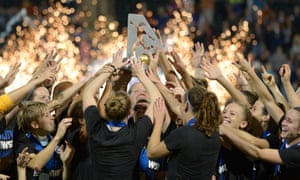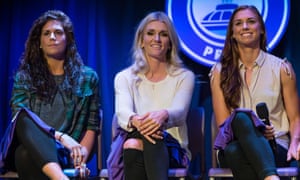Could 2015 be the turning point for women’s soccer in America? That will depend on what happens next year and beyond, but here’s what we do know: 2015 was perhaps the best year to date and could signal better times to come.
Such optimism may seem incongruous with some of the biggest headlines of the year, such as the highly publicized turf battle and its accusations of gender discrimination. But the lowlights hint at a rising expectation for what women’s soccer can achieve and what it can be about.
Here is a look at the ups and downs of 2015 in the National Women’s Soccer League and women’s soccer in US.
The ups
The third time’s a charm
It was the big talking point heading into 2015: the US has never made it past three years with a women’s professional soccer league. But now, with 2015 coming to a close and all of the NWSL’s clubs confirmed to be returning next year, it looks all but certain the streak has been broken.

For the first time, no teams folded, and attendance went up over a three-year period instead of down. Those seem like simple benchmarks, but the previous two attempts at women’s soccer leagues, both lasting three years, had troubled paths, even when the Women’s United Soccer Association started shortly after the 1999 Women’s World Cup and attempted to capitalize on momentum that hasn’t been seen again until this year.
The NWSL may be the most conservative and small-scale attempt at making women’s soccer work on the national level, but the feeling around it is that it’s the right way forward. Clubs that existed long before the NWSL report better financials than years past. While tighter budget caps may mean attracting fewer splashy names, like Brazil’s Marta, who earned as much as $500,000 in a previous league, the NWSL appears to be growing organically, gradually attracting abroad talent for its level of play and organizational structure.
Expanding on a good thing
If there’s one metric that indicates whether a franchising endeavor is succeeding or not, it’s probably growth. For the NWSL, that means expansion, and that’s where 2015 saw a big growth spurt. Orlando City, which has quickly become one of Major League Soccer’s most popular franchises, became the next team to join the NWSL amid many interested ownership groups, signaling that the young league is being taken more and more seriously as a viable business opportunity.
Expansion for the sake of it isn’t enough – the quality of new teams matter and Orlando, following in the footsteps of other MLS predecessors, seems to have all the right pieces in place to push the NWSL in the right direction. The club quickly set out for big names, including former US national coach Tom Sermanni and star striker Alex Morgan, and set a bar of 10,000 fans per game. As of this month, the club surpassed 2,500 season ticket-holders.

It’s not as if other attempts at a women’s league in the US didn’t expand, but the problem was they contracted too. In three years, Women’s Professional Soccer had three expansion teams join, but also had three teams fold before the league shut down in 2012. NWSL is the first league to expand without also shrinking, and it is also the first league to attract existing MLS-backed franchises.
NWSL feels a big World Cup bump
The US women’s national team won a World Cup. That’s a big highlight itself. For the first time in 15 years, Americans could claim they were the best in the world, and their victory capped off the storied careers of Abby Wambach and others.
But the best part of the Women’s World Cup was the ripple effect it had – and it started with a very large ripple. The tournament in Canada set a new record for Women’s World Cup attendance, selling 1.4 million tickets, many of them to Americans. It was a smash over the airwaves too, setting a new record for soccer on American television, despite Fifa giving Fox Sports the tournament for free as part of a bid to broadcast the men’s World Cup.
The effect on the NWSL was immediate. Attendance shot up and the league did what its predecessors couldn’t: not only did attendance numbers hold, but they trended upward and hit new levels. NWSL commissioner Jeff Plush credited the World Cup with not just bringing new fans to women’s soccer, but helping fans realize the NWSL exists. Whatever it was, it worked and it appeared women’s club soccer was finally in a good place in the US.
The downs
NWSL doesn’t cash in with sponsors
If 2015 proved anything, it’s that women’s soccer sells. Whether it’s Carli Lloyd for Comcast, Abby Wambach for Gatorade, Alex Morgan for Coca-Cola or one of the other sponsorships from soccer’s top females, companies are willing to pay to reach the audience that follows women’s soccer. US Soccer courts its share of sponsors for friendlies hosted for the women’s national team and practically all the national team players have sponsorship deals – but where was the NWSL was all these contracts were being signed?
It shouldn’t be that hard – the NWSL has a lot going for it. Many of the best players in the world play in the league, it has the some of the best attendances in women’s soccer, and the level of play is highly competitive. But after the World Cup, when the league saw a big bump in attendance and interest, new sponsorships didn’t follow, even as the NWHL, a pro women’s hockey league, landed Dunkin’ Donuts as its first sponsor earlier this month.
To be sure, the set-up of the NWSL is unique. US Soccer operates the league headquarters and subsidizes the salaries of national team players to give individual clubs budget relief. In that sense, landing a big-money sponsorship may not be first on the priority list. But the long-term viability of the league will depend on its ability to fund itself or turn into a money-maker for US Soccer.
The raging turf debate
By the time 2015 rolled around, it was not a shock that Fifa was forging ahead with a World Cup on artificial turf, something the men’s version of the tournament had never seen. A group of players, mostly Americans, battled through the legal means available, but it was too little, too late, and the tournament went ahead as planned.
The positive was that high-profile supporters, from star athletes of both genders to Capitol Hill, backed the women in the legal fight and the players said Fifa indicated they wouldn’t try to put a Women’s World Cup on artificial turf again. Even amid losing the short-term battle, it seemed perhaps they had won the war. So, when the US women won the World Cup trophy, it was something of a head-scratcher that US Soccer put most of their victory tour games on artificial turf.
The situation reached a breaking point when the US women refused to play on a sub-standard turf in Hawaii. The fallout was regrettable all around – disappointed fans, lost revenue for players and the federation, lawsuits and embarrassment for US Soccer. But after years of being subjected to different standards for playing surfaces than the US men’s team, the women finally put their feet down.
It was unfortunate it had to come to such drastic measures, but that the players now feel they are in a position to demand equal treatment is something of a milestone of its own. A change had to start somewhere, and we perhaps witnessed it this year.
Hope Solo’s off-field antics
The fact that Hope Solo’s spot on the US national team and, to a lesser extent, the Seattle Reign was even debated seemed, at times, more about sports media trying to find a new way to talk about the NFL and male athletes like Ray Rice. But the fact that a female soccer player was deemed worthy of NFL-level outrage was something of a milestone, even if a dubious one.
There is no defending what Solo was accused of – allegedly assaulting her sister and teenage nephew last year, even if the comparisons between her and Rice were not necessarily valid. But Solo did herself no favors by following the ordeal with more poor judgment that involved letting her husband get behind the wheel of a US Soccer-rented van after a night of drinking.
Solo forced her federation’s hand and was finally suspended less than five months before the Women’s World Cup, but the skies seemed to part just in time for the tournament, where she won the Golden Glove. Solo’s problems were a disappointment for fans of the sport, but the debate she generated surely signaled women’s soccer had crossed into new territory.
The best of the NWSL
Best goal
It was a goal that anyone who followed the NWSL this year probably remembers. With full-time close, the Thorns were down a player and down a goal and, in an act of desperation, goalkeeper Michelle Betos trudged up the field for a corner kick. No one on FC Kansas City seemed concerned with marking Betos and, well, a tie felt like a win that evening at Providence Park.
Best player
The storyline seemed to write itself. Crystal Dunn was the final cut from national team coach Jill Ellis’ World Cup roster, so all Dunn could do was try to prove Ellis wrong in the NWSL. Given Dunn’s prominent role on the national team victory tour after the World Cup, perhaps she did it. The 23-year-old led the league with 15 goals, and played with purpose, showing she can be force on both sides of the ball. Her future in the NWSL looks bright and a plane ticket to the 2016 Olympics in Rio with the national team looked all the more likely after a stellar club season.
Best coach
It’s tempting just hand Laura Harvey the award and call it a day. Her ability to acquire talent and sneak her way into trades that have nothing to do with Seattle Reign for her club’s benefit is nothing short of impressive. She’s an excellent coach and general manager. But twice, the Reign have fallen short to one other coach: Vlatko Andonovski. It’s not just that he has won the NWSL championship back-to-back. It’s his ability to get his players to buy-in, gel together and play the kind of soccer everyone seems to want to watch. Andonovski has managed the regular season and playoff system to a tee and deserves to be considered the league’s top coach.
Best fans
If measured simply by gallons of paint, there’s no contest. Led by the Rose City Riveters supporters group, the Portland Thorns regularly draw the kind of loud, enthusiastic crowds that some MLS clubs would like. It’s not just the off-shoot of the Timbers Army supporters group that roots for the MLS side in Portland, though. The Thorns averaged over 15,000 fans in the 2015 season, making them perhaps the best-supported women’s club in the world.



